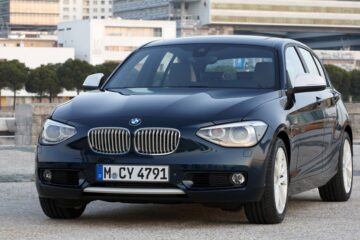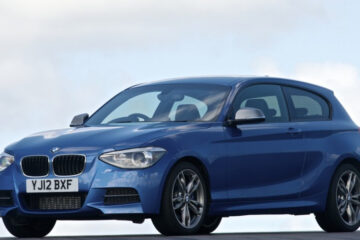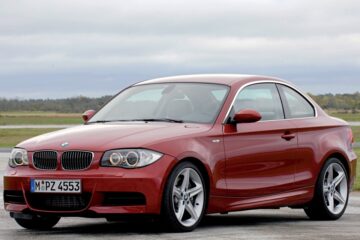In the first series, the BMW concern offered buyers several body versions. The first one was shown and came off the assembly line E87 hatchback. This event took place in 2004. The car was produced for 7 years, having gone through restyling in 2007. The hatchback of the first series is a compact rear-wheel drive car, the engine of which is located longitudinally.
Appearance
The first thing a buyer pays attention to is the exterior of the car. Therefore, let’s start the review of BMW hatchback 1 series with the exterior.
The frame of the car with reinforced sidewall gives it a large margin of safety. There are bi-xenon headlights at the front. The hood of the car with a barely noticeable relief. The grille consists of two sections. The bumper with a chrome line is completed with small-sized fog lights and moldings. Under it there is a hose for headlight washer. In profile, you can notice slightly swollen wheel arches. A deep line of stamping is noticeable at the top of the car. The manufacturer decided to make the mirrors small, so they are uncomfortable and there may be problems with them. Many cars have pneumatic tires, which are subject to depressurization. Self-supporting tires (RUNFLAT technology is used) can be installed on E87. These tires allow the car to continue driving even if there is no pressure!
Small headlights can be seen on the stern of the car. On the luggage compartment lid there is a rear window wiper. There is a large bumper with a beautiful lower curve and molding, made in the body color of the hatchback.
The BMW 1 Series E87 is limited to 423.9 cm in length, 174.8 cm in width and 142.1 cm in height. The hatchback’s ground clearance is 14.5 and its wheelbase is 2.66 cm. Based on the modification, the vehicle weighs between 1275-1685 kg.
Interior
The interior of the BMW 1 Series e87 has been thoughtfully designed. It has ergonomics and is made of quality materials. The interior is quite spacious and quite solid. The door trim on the inside has always been BMW’s aesthetic. The E87 has added functionality. There are illumination lamps in door handles. The German manufacturer has so arranged the control functionality that the driver can operate the car “with closed eyes”. In the steering system, the central place is occupied by a large steering wheel. It has leather trim and is equipped with buttons for controlling the audio system.
The driver/owner will get the ultimate comfort and maximum enjoyment. More comfortable conditions have been created for the driver’s car seat. The driver’s and front passenger’s seat adjustment has a wide range. There is heating and lateral support. As an option, for adherents of dynamic driving, sports seats with lumbar support are offered. On the back row, too, there are adjustment options for a comfortable ride. However, there is much less free space.
As for the volume of the luggage compartment, it varies in the range of 260-360 liters, but if the back of the sofa is folded, the figure increases, 1150.
Electronics
The availability of the navigation system depends on the equipment of the car. This also applies to the saturation of electric controls.
Many 1st gen models have electric power steering. But the E87 doesn’t. It has power steering. Its principle of operation is to develop a force proportional to the force with which the wheels of the hatchback resist the turn. Sometimes the electronics can give a message Active Steering. This indicates a problem in the steering rails. The cruise control system is adjusted by means of a paddle switch.
There are devices that adjust belt pretensioning. Electronic Dynamic Stability Control DSC, which includes all functions of the ABC/ASC systems, constantly monitors the vehicle’s behavior.
The PDC system allows the BMW driver to avoid collisions with other vehicles. In the event of a dangerous approach, it will sound an acoustic signal. The proximity alarm is particularly important when parking. GPS can be fitted for easy navigation.
All of these were active safety features. But the E87 has a good passive safety system as well. This includes 6 airbags/safety belts, seat head restraints, energy-absorbing elements (bumper) that crumple on impact, folding steering column, safety glass and so on. The panel in the color of the interior appeared between the sill line and armrest, functional pockets – at the bottom of the upholstery. The instrument panel of the hatchback is equipped with 2 analog gauges with chrome edging. The on-board computer gives information about the hatchback. Vertical smooth lines prevail on the panel. With their help, the main console harmoniously enters the structure of the panel.
The center console is complete with a small multimedia system monitor with navigation functions. Below are 2 air deflectors, emergency alarm/locking windows. The climate control unit has a lot of buttons. Underneath is a slot for CD disks and buttons that allow you to switch songs.
The E87 supports Bluetooth cell phones. Therefore, you will always be in touch with the outside world while traveling. You can connect your bluetooth phone or tablet to the car. This will allow you to synchronize your phone book (hands-free conversations), play music, and use mobile office functions. Control is allowed in three ways:
- through the multirole,
- by voice command,
- with the iDrive controller.
It is controlled by buttons on the center console, operation modes are displayed on the central monitor. It is possible to install 1-zone or 2-zone air conditioner. The difference is that in case of two zones (front, rear) it is possible to set different temperatures.
The car has a rain and light sensor that automatically turns on the wipers and headlights.
If you use the Comfort Access System, you can lock/unlock the hatchback without actively using the ID transmitter.
Engine
Among the technical features, the main focus is on the engines. They can be started with the ignition key or the alternative start-stop button.
The car consumes AI-95 fuel on the highway/city 6/11 liters per 100 km. A rigid independent suspension is used, which is not liked by many car owners due to lack of comfort. The front disc brakes are ventilated.
However, the BMW E87’s engine lineup is extensive.
At the beginning of production, the cars were equipped with two gasoline and two turbodiesel engines (installed on cars with D marking, for example, 118D) with a capacity of 1.6/2 liters. The most powerful was the 120D version. The 163-horsepower engine accelerated the car to a hundred in only 8 seconds. In 2005. Two models appeared in the lineup of cars. They were BMW 118I E87, equipped with a 1.8 engine, and 130I, equipped with a powerful six-cylinder power plant, running on gasoline. 265 hp allowed the hatchback to reach 100 km/h in 6 seconds.
The motors are equipped with Valvetronic, which adjusts the valve lift height.
So how many liters of oil are in the motor? If they are gasoline units, BMW 116i e87, 118i or BMW 120i e87, its volume is 4.2 liters (only the 130i has 6.5). Diesel engines have 5.5.
Notice the motors aren’t the most powerful, and the weights of BMW cars are comparatively large. E87 took, practically, ideal weight distribution. The 1st generation cars were extremely stable on the road, and hatchbacks were legendary for cornering at speed.
If you do not want to warm up the engine before driving, use the autostart. It can be operated with the key. Press LOCK on the remote control three times to start the engine. It can also be operated via cell phone.
Features
BMW E87 replaced the E46 Compact series on the assembly line. Having its own platform, the model was able to retain in its design and traditional proportions, which are inherent in all cars of the concern. There are short overhangs with a long wheelbase, which make the German car noticeably recognizable. Some components were taken from other models.
From BMW E60 hatchback got MacPherson struts, trapezoidal rear axle and front suspension. The rear multilink suspension is taken from BMW E90. Rear shock absorbers can be put from Sachs (budget variant) or from Boge.
It was officially stated that the E87 borrowed over 60% of components from other models. The cars were assembled in the German city of Regensburg, the engines were supplied from the English Birmingham, from the Hams Hole plant. In terms of sales the E87 was exceptionally successful. A total of 149,493 cars were sold. Only the 3-series and 5-series cars were sold more.
Perhaps, the additional influx of BMW 1 Series buyers was provided by the safety characteristics of Euro NCAP. The car’s rating is 33 on a maximum scale of 37 points.
The hatchback used independent coil spring suspension front and rear.
The main advantages of the car:
- Powerful powertrains;
- Good dynamics;
- Excellent noise insulation;
- Attractive design;
- Reliability;
- Rich equipment;
- Low cost of maintenance;
- Fantastic handling.
Disadvantages of the model – fuel consumption, stiff suspension, little space in the back, lack of a spare and repair kit.
Difference between restyling and prerestyling
3 years after its release, in 2007, the hatchback underwent restyling. German designers changed the appearance of the car, changed the radiator grille and bumper. Two years later, the mirrors were changed, because the Euro standards have changed. When updating the exterior and interior, the specialists made the main emphasis on the front and rear parts. After re-styling, the hatchback got a raised radiator grille, received modified spoilers and an extended air intake was installed on it (it was placed at the bottom of the front apron).
These changes gave the car a sporty look and improved airflow to the powertrain. The dimensions of the front headlights have not changed, but they have a new shape. It is especially noticeable if you look from the side of the bumper module. Headlight trim has become darker. And the headlights at the rear have retained their shape, but they have a new arrangement of lights. To create an impression of low and wide landing, Germans have modernized bumper. It is achieved due to expressive horizontal lines, dominating on the rear part of the hatchback. The expressiveness of proportions is emphasized by an elongated hood with the interior slightly shifted back.
Generations and equipment
1 generation – restyling
03.2007 – 08.2011
| 116i MT Base | N43B16 | 1.6L | 116 hp |
| 116i AT Base | N43B16 | 1.6L | 116 hp |
| 118i MT Base | N43B20 | 2.0L | 136 hp |
| 118i AT Base | N43B20 | 2.0L | 136 hp |
| 120i MT Base | N43B20 | 2.0L | 156 hp |
| 120i AT Base | N43B20 | 2.0L | 156 hp |
| 120d MT Base | N47D20 | 2.0L | 177 hp |
| 120d AT Base | N47D20 | 2.0L | 177 hp |
| 123d MT Base | N47D20 | 2.0L | 204 hp |
| 123d AT Base | N47D20 | 2.0L | 204 hp |
| 130i MT Base | N52B30 | 3.0L | 265 hp |
| 130i AT Base | N52B30 | 3.0L | 265 hp |
1 generation
09.2004 – 02.2007
| 116i MT Base | N45B16 | 1.6L | 115 hp |
| 118i MT Base | N46B20 | 2.0L | 129 hp |
| 118i AT Base | N46B20 | 2.0L | 129 hp |
| 120i MT Base | N46B20 | 2.0L | 150 hp |
| 120i AT Base | N46B20 | 2.0L | 150 hp |
| 130i MT Base | N52B30 | 3.0L | 265 hp |
| 130i AT Base | N52B30 | 3.0L | 265 hp |



0 Comments